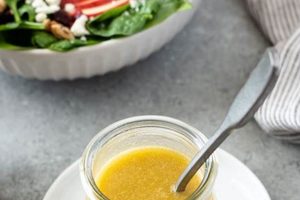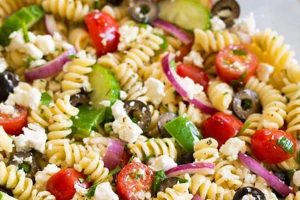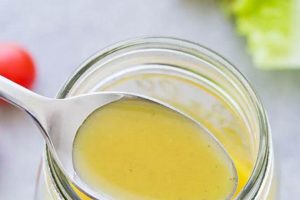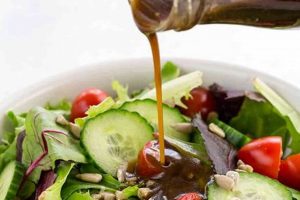A vinaigrette featuring balsamic vinegar as its core acidic component constitutes a foundational element of many cuisines. Such dressings typically combine the vinegar with oil, often olive oil, and may be augmented with sweeteners like honey or maple syrup, as well as seasonings such as Dijon mustard, garlic, salt, and pepper. A simple example includes equal parts balsamic vinegar and olive oil, whisked together with a pinch of salt and pepper.
The deep, slightly sweet, and tangy flavor profile imparted by balsamic vinegar offers a versatile foundation for enhancing a wide array of salads. From simple green salads to more complex compositions involving roasted vegetables, fruits, cheeses, or nuts, the richness of balsamic vinegar adds depth and complexity. Historically, balsamic vinegar originates from Modena, Italy, where traditional production methods result in a highly prized, aged product. While such traditional balsamic vinegars are expensive, more widely available varieties still deliver a characteristic flavor that elevates simple dressings.
This exploration will delve further into variations on the basic balsamic vinaigrette, offering recipes incorporating diverse ingredients and flavor profiles. Techniques for emulsion stability, ingredient selection, and pairing suggestions will also be discussed to provide a comprehensive understanding of crafting and utilizing balsamic-based dressings effectively.
Tips for Crafting Exceptional Balsamic Vinaigrettes
Achieving a well-balanced and flavorful balsamic vinaigrette requires attention to detail and an understanding of the interplay of ingredients. The following tips offer guidance for elevating dressings from simple to extraordinary.
Tip 1: Quality Ingredients Matter: Opting for high-quality balsamic vinegar is paramount. While aged, traditional balsamic vinegars offer unparalleled complexity, more affordable options can still produce delicious results. Look for vinegars with a balanced sweetness and acidity.
Tip 2: Emulsification is Key: A stable emulsion prevents the oil and vinegar from separating, resulting in a creamy, cohesive dressing. Whisk the ingredients vigorously or use a blender to create a proper emulsification.
Tip 3: Balance Sweetness and Acidity: The inherent sweetness of balsamic vinegar can be further enhanced with a touch of honey, maple syrup, or a pinch of sugar. Adjust the amount to achieve the desired balance with the vinegar’s acidity.
Tip 4: Explore Flavor Combinations: A wide array of ingredients complements balsamic vinegar. Consider incorporating Dijon mustard, minced garlic, shallots, fresh or dried herbs, or spices like black pepper.
Tip 5: Seasoning is Crucial: Salt is essential for enhancing the flavors of the other ingredients. Start with a small amount and adjust to taste. Freshly ground black pepper adds a touch of complexity.
Tip 6: Taste and Adjust: Before serving, taste the dressing and adjust the seasoning as needed. Additional vinegar, oil, sweetener, or seasonings can be added to achieve the perfect balance.
Tip 7: Proper Storage: Store leftover dressing in an airtight container in the refrigerator for up to a week. Shake well before using, as some separation may occur.
By following these guidelines, one can create balsamic vinaigrettes that enhance the flavors of any salad, transforming a simple dish into a culinary experience.
These tips offer a starting point for creating flavorful and versatile balsamic vinaigrettes. Experimentation and adaptation to personal preferences will ultimately lead to the discovery of ideal combinations.
1. High-quality balsamic vinegar
The quality of balsamic vinegar significantly impacts the overall flavor profile of a balsamic vinaigrette. Selecting a superior vinegar is foundational to crafting a truly exceptional dressing. The nuances of a high-quality balsamic vinegar contribute depth, complexity, and a balanced sweetness that elevates the final product.
- Acidity and Sweetness
High-quality balsamic vinegar possesses a harmonious balance between acidity and sweetness. This balance is crucial for achieving a dressing that is neither overly sharp nor cloyingly sweet. The aging process contributes to the development of this balanced profile, as the vinegar mellows and develops complex flavors over time. Inferior vinegars may lack this crucial balance, resulting in a one-dimensional dressing.
- Density and Texture
A good balsamic vinegar will have a noticeable viscosity, often clinging to the sides of a bottle or spoon. This texture contributes to the mouthfeel of the dressing, adding a richness that complements the other ingredients. A thinner, watery balsamic often indicates a lower quality product, lacking the concentrated flavors developed through proper aging.
- Depth of Flavor
Beyond simple sweetness and acidity, a high-quality balsamic vinegar exhibits a complex depth of flavor. Notes of fig, molasses, cherry, or even chocolate can be present, depending on the aging process and grape varietal used. These nuanced flavors add layers of complexity to the vinaigrette, transforming it from a simple dressing into a sophisticated culinary element.
- Production Methods
Traditional balsamic vinegars from Modena, Italy, adhere to strict production methods, including aging in wooden barrels for extended periods. These traditional methods contribute significantly to the quality and complexity of the vinegar. While these vinegars command a higher price, even more accessible balsamic vinegars can offer excellent quality when produced with care and attention to detail.
Ultimately, investing in a high-quality balsamic vinegar is an investment in the overall quality of the final balsamic vinaigrette. The superior flavor, texture, and complexity contribute significantly to the sensory experience, elevating a simple salad into a culinary delight. Discerning the characteristics of a quality balsamic vinegar empowers one to create dressings that truly showcase the potential of this versatile ingredient.
2. Appropriate oil selection
Oil selection significantly influences the flavor profile, texture, and overall quality of a balsamic vinaigrette. The oil acts as a carrier for the other ingredients, distributing flavors throughout the dressing and contributing to the final mouthfeel. Compatibility with balsamic vinegar’s intense flavor is paramount; an oil that complements rather than overpowers the vinegar is crucial.
Extra virgin olive oil is a frequent choice, offering a fruity, peppery flavor that harmonizes well with balsamic vinegar. Its robust character can stand up to the vinegar’s acidity while adding its own distinct notes. For a milder flavor, lighter olive oils or grapeseed oil offer a neutral backdrop, allowing the balsamic vinegar to take center stage. Nut oils, such as walnut or hazelnut oil, introduce another layer of complexity, their earthy, rich flavors pairing well with balsamic vinegar, particularly in dressings for autumnal salads or those featuring roasted vegetables. Avocado oil, with its creamy texture and subtle flavor, provides a smooth, luxurious mouthfeel and complements the vinegar’s tang.
Consider the salad’s other components when selecting an oil. Delicate greens may benefit from a lighter oil, while heartier ingredients can handle more robust flavors. The intended use of the dressing also plays a role. A simple vinaigrette for everyday use might call for a readily available olive oil, while a special occasion dressing might warrant a higher-quality, specialty oil. Understanding the interplay between oil and balsamic vinegar empowers one to craft vinaigrettes tailored to specific flavor profiles and culinary applications. Careful oil selection is not merely a detail but a crucial step in achieving a well-balanced and delicious balsamic vinaigrette.
3. Balanced sweetness/acidity
The interplay of sweetness and acidity defines the character of a balsamic vinaigrette. Balsamic vinegar, inherently possessing a sweet and tangy profile, requires careful balancing to prevent the dressing from becoming overly sweet or excessively sharp. This balance is crucial for achieving a harmonious flavor profile that complements the other salad ingredients.
The inherent sweetness of balsamic vinegar varies depending on the specific product. Some vinegars lean towards a more pronounced sweetness, while others possess a sharper, more acidic character. This variation necessitates adjustments in the recipe to achieve the desired balance. A touch of sweetener, such as honey, maple syrup, or a pinch of sugar, can enhance the sweetness if needed. Conversely, a squeeze of lemon juice can brighten the acidity if the balsamic vinegar is overly sweet. The specific ingredients and their proportions are adjusted based on the individual balsamic vinegar used.
For example, a salad featuring peppery arugula and sharp Parmesan might benefit from a dressing with a more pronounced acidity to cut through the richness and bitterness of the greens and cheese. In this scenario, a balsamic vinaigrette with a slightly higher proportion of vinegar and a touch of lemon juice would create a balanced and complementary flavor profile. Conversely, a salad with sweeter ingredients, such as roasted beets or candied nuts, might benefit from a balsamic vinaigrette with a slightly enhanced sweetness. In this instance, a touch of honey or maple syrup would harmonize with the existing sweetness of the salad components. Understanding this interplay allows for tailored adjustments, optimizing the dressing for specific salad compositions.
Achieving this balance requires careful tasting and adjustment throughout the preparation process. Small increments of sweetener or acid are added, and the dressing is tasted after each addition. This iterative process allows for precise control over the final flavor profile. The goal is not simply to achieve a neutral flavor but rather to create a dynamic interplay between sweetness and acidity that enhances the overall sensory experience. A well-balanced balsamic vinaigrette elevates a simple salad, transforming it into a dish with depth and complexity. This balance ensures that the dressing complements the salad, enhancing the flavors of the other ingredients rather than masking them.
4. Complementary Seasonings
Complementary seasonings are essential for elevating a basic balsamic vinaigrette from simple to sophisticated. These additions introduce layers of complexity, balancing the sweetness and acidity of the balsamic vinegar while enhancing the overall flavor profile of the salad. Strategic selection and application of seasonings can transform a standard vinaigrette into a customized culinary creation.
- Herbs
Fresh herbs offer a vibrant, aromatic dimension to balsamic vinaigrettes. Classic choices include basil, oregano, thyme, and rosemary. Delicate herbs like chives, parsley, and mint provide a refreshing counterpoint to the richness of the balsamic. The selection should complement the other salad ingredients; for instance, a Caprese salad benefits from the addition of fresh basil, while a Greek salad pairs well with oregano.
- Spices
Ground spices contribute warmth and depth. Black pepper is a standard addition, offering a subtle bite. Garlic powder, onion powder, or smoked paprika introduce savory notes. A pinch of red pepper flakes adds a touch of heat. The choice of spices depends on the desired flavor profile and the other salad components. A salad featuring roasted vegetables might benefit from the addition of smoked paprika, while a simpler green salad might only require black pepper.
- Alliums
Members of the allium family, such as garlic, shallots, and red onions, impart pungent, savory flavors. Minced garlic or finely chopped shallots add a sharp note that balances the sweetness of the balsamic. Red onions, with their milder flavor and vibrant color, contribute both flavor and visual appeal. The quantity and type of allium should be carefully considered, as their strong flavors can easily overpower a delicate salad.
- Mustard
Dijon mustard is a frequent addition to balsamic vinaigrettes, adding a tangy, slightly spicy complexity. The emulsification properties of mustard also help stabilize the dressing, preventing separation of the oil and vinegar. A small amount of Dijon enhances the overall flavor profile without overpowering the other ingredients.
The careful integration of complementary seasonings elevates a balsamic vinaigrette from a simple mixture of oil and vinegar to a nuanced and flavorful dressing. By considering the interplay of flavors and textures, one can create a vinaigrette tailored to specific salad compositions, enhancing the overall dining experience. Experimentation with different combinations of herbs, spices, alliums, and mustard allows for the development of unique and personalized balsamic vinaigrette recipes.
5. Proper Emulsification Technique
Proper emulsification is crucial for a successful balsamic vinaigrette. Emulsification refers to the process of combining two immiscible liquids, in this case, oil and vinegar, into a stable mixture. Without proper emulsification, the dressing will separate, resulting in an uneven distribution of flavor and a less appealing texture. A properly emulsified balsamic vinaigrette exhibits a cohesive, creamy consistency, ensuring that the flavors are evenly dispersed throughout the dressing and cling to the salad ingredients. This contributes to a more harmonious and enjoyable sensory experience.
Several methods achieve emulsification in a balsamic vinaigrette. The most common is vigorous whisking. Continuously whisking while slowly drizzling the oil into the vinegar allows the oil droplets to disperse evenly within the vinegar, creating a stable emulsion. A blender or food processor offers a more efficient method, particularly for larger volumes. The high-speed blending action creates a finer emulsion, resulting in an even smoother and more stable dressing. Adding an emulsifying agent, such as Dijon mustard or honey, further enhances stability. These ingredients contain compounds that help bind the oil and vinegar together, preventing separation. For example, the lecithin in mustard acts as a natural emulsifier.
The practical significance of proper emulsification extends beyond the immediate visual appeal and texture of the dressing. A stable emulsion ensures a consistent flavor experience with each bite. When the oil and vinegar separate, the flavors become unbalanced, resulting in some bites tasting predominantly of oil and others of vinegar. Proper emulsification guarantees that the flavors of the balsamic vinegar, oil, and other seasonings are evenly distributed, creating a harmonious and balanced flavor profile throughout the salad. Furthermore, a stable emulsion helps the dressing cling to the salad ingredients more effectively, ensuring that each leaf or vegetable is coated with the flavorful vinaigrette. Understanding and implementing proper emulsification techniques is essential for creating a high-quality balsamic vinaigrette that enhances the overall dining experience.
Frequently Asked Questions
This section addresses common inquiries regarding balsamic vinaigrette preparation and utilization.
Question 1: What is the ideal ratio of balsamic vinegar to oil in a vinaigrette?
While a 1:1 ratio serves as a common starting point, the optimal balance depends on the specific balsamic vinegar and desired flavor profile. A sweeter balsamic may necessitate a higher proportion of oil, while a more acidic vinegar may benefit from a lower proportion.
Question 2: How can separation in a balsamic vinaigrette be prevented?
Vigorous whisking while slowly drizzling the oil into the vinegar is crucial for creating a stable emulsion. Adding an emulsifying agent, such as Dijon mustard or honey, further aids in preventing separation.
Question 3: What types of oils are best suited for balsamic vinaigrettes?
Extra virgin olive oil is a classic choice, but other oils, such as avocado, walnut, or grapeseed oil, offer distinct flavor profiles that can complement balsamic vinegar.
Question 4: How long can balsamic vinaigrette be stored?
Stored in an airtight container in the refrigerator, balsamic vinaigrette typically remains viable for up to one week. Separation may occur during storage; shaking well before use re-emulsifies the dressing.
Question 5: Can balsamic vinaigrette be used for marinades?
The robust flavor profile of balsamic vinegar lends itself well to marinades for meats, poultry, and vegetables. The acidity helps tenderize the proteins, while the sweetness adds depth of flavor.
Question 6: How can one adjust the sweetness or acidity of a balsamic vinaigrette?
Small additions of honey or maple syrup increase sweetness, while a squeeze of lemon juice enhances acidity. Taste and adjust incrementally until the desired balance is achieved.
Understanding these fundamental aspects of balsamic vinaigrette preparation empowers one to create customized dressings tailored to specific preferences and culinary applications.
The following section will explore specific balsamic vinaigrette recipes incorporating various flavor combinations and ingredient pairings.
Crafting the Perfect Balsamic Vinaigrette
This exploration has delved into the nuances of crafting exceptional balsamic vinaigrette. From the selection of high-quality balsamic vinegar and complementary oils to the delicate balance of sweetness and acidity, each component contributes significantly to the final product. Proper emulsification techniques ensure a harmonious blend of flavors and textures, while the strategic incorporation of seasonings elevates the vinaigrette from simple to sophisticated. Understanding these fundamental principles empowers culinary enthusiasts to create dressings tailored to individual preferences and specific salad pairings.
The potential of balsamic vinaigrette extends beyond basic salads. Its versatility allows for application as a marinade, a glaze for roasted vegetables, or a flavorful addition to sandwiches and grain bowls. Continued experimentation with diverse ingredients and flavor combinations promises further culinary discoveries, solidifying balsamic vinaigrette’s position as a versatile and essential element in any kitchen.






